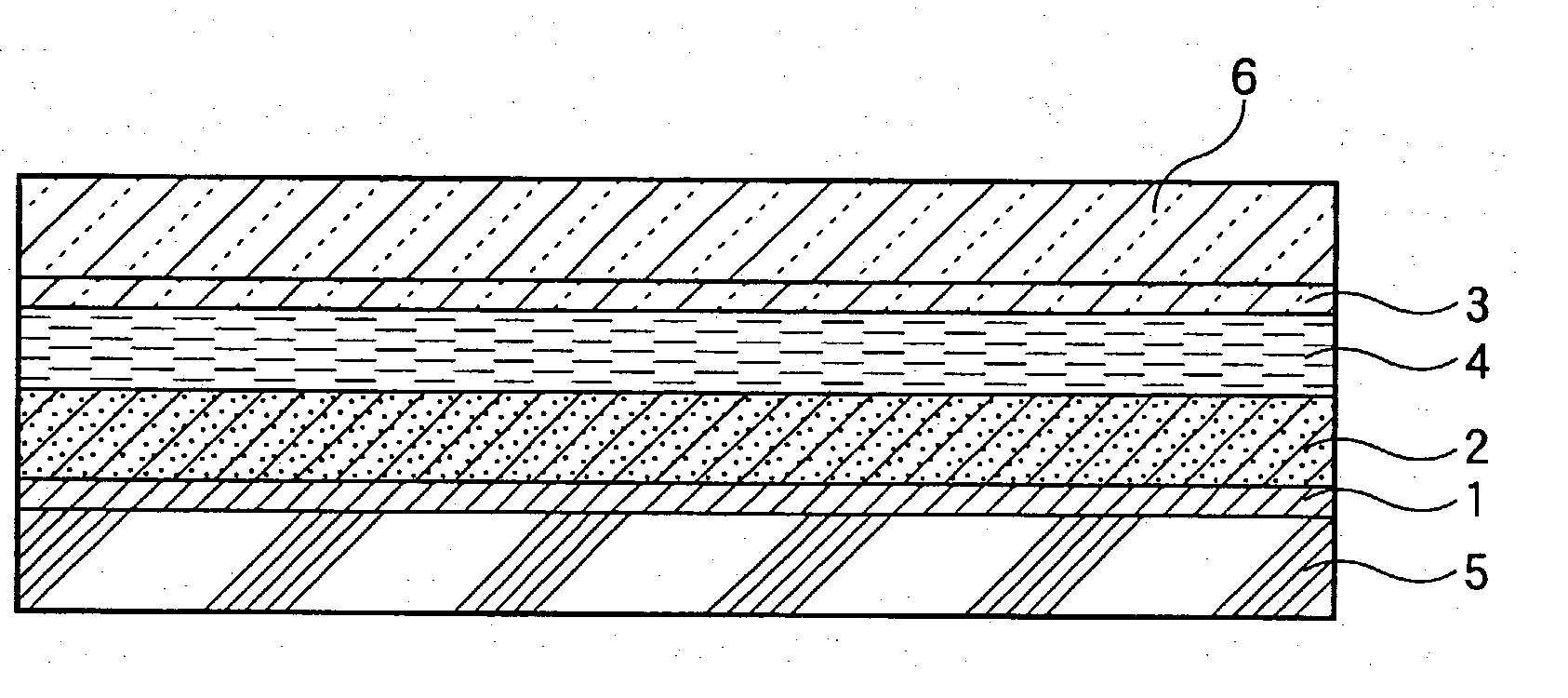Photovoltaic cell
a photovoltaic cell and photovoltaic technology, applied in the field of photovoltaic cells, can solve the problems of lowering the adsorption amount of spectrosensitizing dye is decreased, and the photoelectric conversion efficiency is not always satisfactory, so as to achieve smooth movement to the electrode, high photoelectric conversion efficiency, and high electromotive force
- Summary
- Abstract
- Description
- Claims
- Application Information
AI Technical Summary
Benefits of technology
Problems solved by technology
Method used
Image
Examples
example 1
[0120] Formation of Metal Oxide Semiconductor Film (A)
[0121] In 1 liter of pure water, 5 g of titanium hydride was suspended. To the suspension, 400 g of a hydrogen peroxide solution having a concentration of 5% was added over a period of 30 minutes, and they were heated to 80.degree. C. to prepare a solution of peroxotitanic acid. Then, 90% of the solution was dispensed, and thereto was added concentrated aqueous ammonia to adjust the solution to pH 9. The solution was placed in an autoclave and subjected to hydrothermal treatment at 250.degree. C. for 5 hours under saturated vapor pressure to prepare a dispersion of titania colloidal particles (A). As a result of X-ray diffractometry, the particles proved to be those of anatase type titanium oxide having high crystallinity. The average particle diameter is set forth in Table 1. Subsequently, the dispersion of titania colloidal particles (A) obtained above was concentrated to at concentration of 10%, and the resulting dispersion wa...
example 2
[0134] Formation of Metal Oxide Semiconductor Film (B)
[0135] To 1000 g of a dispersion of titania colloidal particles (A) having a concentration of 10% by weight obtained in the same manner as in Example 1, 110 g of an aluminum nitrate aqueous solution having a concentration of 1% by weight in terms of Al.sub.2O.sub.3 was added, and then aqueous ammonia having a concentration of 15% by weight was added to adjust the dispersion to pH 8.5 and to hydrolyze aluminum nitrate. Subsequently, the dispersion was subjected to heat maturing at 80.degree. C. for 20 minutes, and then ammonium ion, nitric acid ion, etc. were removed by an amphoteric ion exchange resin to obtain a dispersion of titania colloidal particles (B) coated with Al.sub.2O.sub.3 (hydrate) as an inhibitor of back current. The dispersion was concentrated to a concentration of 10% by weight. Then, a titanium oxide semiconductor film (B) containing Al.sub.2O.sub.3 as an inhibitor of back current was formed in the same manner a...
example 3
[0140] Formation of Metal Oxide Semiconductor Film (C)
[0141] To 1000 g of a dispersion of titania colloidal particles (A) having a concentration of 10% by weight obtained in the same manner as in Example 1, 200 g of a yttrium nitrate aqueous solution having a concentration of 1% by weight in terms of Y.sub.2O.sub.3 was added, and then aqueous ammonia having a concentration of 15% by weight was added to adjust the dispersion to pH 7.0 and to hydrolyze yttrium nitrate. Subsequently, the dispersion was subjected to heat maturing at 80.degree. C. for 20 minutes, and then ammonium ion, nitric acid ion, etc. were removed by an amphoteric ion exchange resin to obtain a dispersion of titania colloidal particles (C) coated with Y.sub.2O.sub.3 (hydrate) as inhibitor of back current. The dispersion was concentrated to a concentration of 10% by weight. Then, a titanium oxide semiconductor film (C) containing Y.sub.2O.sub.3 as an inhibitor of back current was formed in the same manner as in Exam...
PUM
| Property | Measurement | Unit |
|---|---|---|
| particle diameter | aaaaa | aaaaa |
| pore diameter | aaaaa | aaaaa |
| temperature | aaaaa | aaaaa |
Abstract
Description
Claims
Application Information
 Login to View More
Login to View More - R&D
- Intellectual Property
- Life Sciences
- Materials
- Tech Scout
- Unparalleled Data Quality
- Higher Quality Content
- 60% Fewer Hallucinations
Browse by: Latest US Patents, China's latest patents, Technical Efficacy Thesaurus, Application Domain, Technology Topic, Popular Technical Reports.
© 2025 PatSnap. All rights reserved.Legal|Privacy policy|Modern Slavery Act Transparency Statement|Sitemap|About US| Contact US: help@patsnap.com


